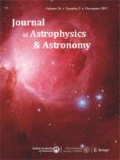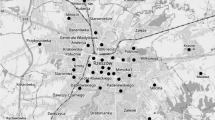Abstract
This paper discusses the influence of light pollution of the night sky on the conditions of visibility of astronomical objects such as planets, stars and comets. This phenomenon has a huge impact on the observability of astronomical objects, especially in cities, where the brightness of the sky makes it difficult or even impossible to conduct astronomical observations. The main purpose of this article is to measure and analyse the surface brightness of the night sky in Rzeszów and its surroundings. A device called the Sky Quality Meter was used to measure the brightness of the night sky. This paper presents measurement results for the years 2015 and 2018, from which it is clear that the quality of the night sky has been deteriorated in terms of the observability of celestial bodies. As an example, the numerical value of the measurement for the centre of Rzeszów has been taken. In 2015, this value was \(18.70\pm 1.87\) mag/arcsec\(^{2}\), while in 2018, it was equal to \(16.73\pm 1.67\) mag/arcsec\(^{2}\). The results obtained were used to analyse the visibility of celestial bodies. Here, particular attention was paid to the analysis of the visibility of comets (also during the outburst), in the context of increasing light pollution of the night sky. Observers in neighboring villages have also experienced a change in the sky quality from Bortle Class V to Class VII, requiring objects to be approximately one magnitude brighter in order to be visible.







Similar content being viewed by others
References
Aubé M., Kocifaj M. 2012, Using two light-pollution models to investigate artificial sky radiances at Canary Islands observatories, MNRAS, 422, 819 (2012)
Bohren C. F., Huffman D. 1983, Absorption and Scattering of Light by Small Particles, Wiley, New York
Bortle J. E. 2001, Introducing the Bortle Dark-Sky Scale, Sky and Telescope, vol. 101, p. 126
Cabot H. et al. 1996, Complementary studies on the unexpected activity of comet Schwassmann–Wachmann 1, Planet & Space Sci., 44, 1015
Cinzano P., Falchi F., Elvidge C. D. 2001a, Naked-eye star visibility and limiting magnitude mapped from DMSP-OLS satellite data, MNRAS, 323, 34
Cinzano P., Falchi F., Elvidge C. D. 2001b, The first World Atlas of the artificial night sky brightness, MNRAS, 328, 689
Cinzano P., Elvidge C. D. 2004, Night sky brightness at sites from DMSP-OLS satellite measurements, MNRAS, 353, 1107
Cinzano P. 2004, A portable spectrophotometer for light pollution measurements, Memorie della Società Astronomica Italiana Suppl., 5, 395
Curtis H. D. 1903, On the limits of unaided vision, Lick Observatory Bull., 2, 67
Davidsson B. J. R., Skorov Y. V. 2002, On the Light-Absorbing Surface Layer of Cometary Nuclei, I, Radiative Transfer, Icarus, 156, 223
Enzian A. et al. 1997, A 2 1/2 D thermodynamic model of cometary nuclei, I, Application to the activity of comet 29P/Schwassmann–Wachmann 1, A&A, 319, 995
Falchi F., Cinzano P., Kyba Ch., Portnov B. 2015, The New World Atlas of Artificial Sky Brightness, IAU Gen. Assemb. 22: 47038F
Fernández J. A. et al. 1999, The population, magnitudes, and sizes of Jupiter family comets, A&A, 352, 327
Garstang R. H. 1989, Night-sky brightness at observatories and sites, Astron. Soc. Pac., 101, 306
Gronkowski P. 2007, The search for a cometary outbursts mechanism: a comparison of various theories, Astron. Nachr., 328, 126
Gronkowski P. 2009, Cometary outbursts: the post-deep impact outlook on collisions as possible causes, MNRAS, 397, 883
Gronkowski P., Wesołowski M. 2012, Collisions of comets and meteoroids: the post stardust-NExT discussion, Astron. Nachr., 333, 721
Gronkowski P., Wesołowski M. 2015, A model of cometary outbursts: a new simple approach to the classical question, MNRAS, 451, 3068
Gronkowski P., Wesołowski M. 2016, A Review of Cometary Outbursts at Large Heliocentric Distances, Earth Moon Planets, 119, 23
Gronkowski P., Wesołowski M. 2017, Ejection of large particles from cometary nuclei in the shape of prolate ellipsoids, Astron. Nachr., 338, 385
Gronkowski P., Tralle I., Wesołowski M. 2018, Visibility of comets during their outbursts and the night sky light pollution – Use the Bortle scale, Astron. Nachr., 339, 37
Groussin O., Lamy P., Jorda L. 2004, The nuclei of comets 126P/IRAS and 103P/Hartley 2, A&A, 419, 375
Hughes D. W. (1990) Cometary outbursts: a review, R. Astron. Soc. Q. J., 31, 6
Hughes D. W. 1991, Comet Halley’s outburst, MNRAS, 251, 26
Ivanova O. V. et al. 2011, Observations of the long-lasting activity of the distant Comets 29P Schwassmann–Wachmann 1, C/2003 WT42 (LINEAR) and C/2002 VQ94 (LINEAR), Icarus, 211, 559
Kossacki K. J., Szutowicz S. 2013, Activity of Comet 29P/Schwassmann–Wachmann 1, Icarus, 225, 111
Montalto M. et al. 2008, The comet 17P/Holmes 2007 outburst: the early motion of the outburst material, A&A, 479, L45
Reach W. T. et al. (2010) Explosion of Comet 17P/Holmes as revealed by the Spitzer Space Telescope. Icarus, 208: 276
Richardson J. E. et al. 2007, A ballistics analysis of the Deep Impact ejecta plume: Determining Comet Tempel 1’s gravity, mass, and density, Icarus, 190, 357
Richter N. B. 1954, Die Helligkeitsausbrüche des Kometen 1925 II und ihre Zusammenhänge mit der Sonnentätigkeit, Astron. Nachr., 281, 241
Ściȩżor T. 2013, A new astronomical method for determining the brightness of the night sky and its application to study long-term changes in the level of light pollution, MNRAS, 435, 303
Tancredi G. et al. 2000, A catalog of observed nuclear magnitudes of Jupiter family comets, A&A Suppl., 146, 73
Trigo-Rodriguez J. M. et al. 2008a, Outburst activity in comets. I. Continuous monitoring of comet 29P/Schwassmann–Wachmann 1, A&A, 485, 599
Trigo-Rodriguez J. M. et al. 2008b, All-Sky Cameras Detection and Telescope Follow-Up of the 17P/Holmes Outburst, Lunar Planetary Science XXXIX, 1627
Trigo-Rodriguez J. M. et al. 2010, Outburst activity in comets – II. A multiband photometric monitoring of comet 29P/Schwassmann–Wachmann 1, MNRAS, 409, 1682
Wesołowski M., Gronkowski P. 2018a, A new method for determining the mass ejected during the cometary outburst – Application to the Jupiter-family comets, New Astron., 62, 55
Wesołowski M., Gronkowski P. 2018b, A New Simple Model of Comets-Like Activity of Centaurs, Earth Moon and Planets, 121, 105
Zamorano J., de Sánchez M. A., Ocaña F. et al. 2016, Testing sky brightness models against radial dependency: A dense two dimensional survey around the city of Madrid, Spain, J. Quant. Spectrosc. Radiat. Transfer, 181, 52
Acknowledgements
The author would like to express his gratitude to the anonymous reviewer for very helpful comments that have considerably improved the quality of the manuscript. This paper was written due to the support the author received from the Centre for Innovation and Transfer of Natural Sciences and Engineering Knowledge at the University of Rzeszów.
Author information
Authors and Affiliations
Corresponding author
Rights and permissions
About this article
Cite this article
Wesołowski, M. Impact of light pollution on the visibility of astronomical objects in medium-sized cities in Central Europe on the example of the city of Rzeszów, Poland. J Astrophys Astron 40, 20 (2019). https://doi.org/10.1007/s12036-019-9586-1
Received:
Accepted:
Published:
DOI: https://doi.org/10.1007/s12036-019-9586-1




